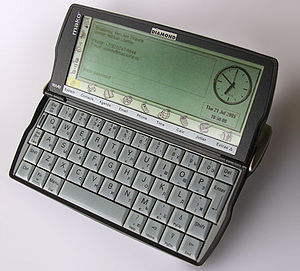
Psion Revo
Encyclopedia

Personal digital assistant
A personal digital assistant , also known as a palmtop computer, or personal data assistant, is a mobile device that functions as a personal information manager. Current PDAs often have the ability to connect to the Internet...
from Psion. It is the successor to the Psion Series 3 and a light version of Psion 5
Psion 5
The Psion Series 5 was a PDA from Psion. It came in two main variants, the Series 5 and the Series 5mx , the latter having a faster processor, clearer screen, and updated software. There was also a rare Series 5mx Pro, which differed only in having the operating system loaded into RAM and hence...
mx. It is software-compatible with the 5mx and has the same processor but is more lightweight (200g vs 354g of 5mx), and substantially smaller (157x79x17mm). In comparison with the Series 5/5mx, the Revo has a smaller screen (480x160 vs 640x240 of Series 5/5mx) and also lacks a flash-card slot and a backlight.
The Psion Revo comes in two main variants, Psion Revo and Psion Revo Plus having 8 and 16MB of RAM respectively. It is powered by a 36 MHz ARM 710T microprocessor. Among other things, the hardware is equipped with a short-distance irDA wireless infrared communication system and a touchscreen. Like its bigger counterpart Series 5mx, it comes with a small suite of office and communications programs built into the ROM chips. Other programs are user-installable by using a 'dock' to send Revo programs from a PC.
SONICblue produced a rebadged version of the Psion Revo Plus called the Diamond Mako which they distributed in the United States and in Canada.
Along with Enfour, Psion produced two versions of the Revo for the Chinese
China
Chinese civilization may refer to:* China for more general discussion of the country.* Chinese culture* Greater China, the transnational community of ethnic Chinese.* History of China* Sinosphere, the area historically affected by Chinese culture...
market called the 618C (Traditional Chinese) and 618S (Simplified Chinese).
An open source project OpenPsion, formerly PsiLinux, aims to port Linux
Linux
Linux is a Unix-like computer operating system assembled under the model of free and open source software development and distribution. The defining component of any Linux system is the Linux kernel, an operating system kernel first released October 5, 1991 by Linus Torvalds...
to the Psion Revo and other Psion PDAs. See the OpenPsion site or the site of Revol, which is an optimized version of OpenPsion for the Revo.
Conan
Shortly before the demise of Psion in the commercial PDA market work had begun on a successor to the Revo, a 3rd generation PDA known by its codename of Conan.The Conan ran Epoc Release 6 and was to feature support for Bluetooth and a backlight, although the former wasn't functional in the development builds.
Battery
Unlike the Series 5mx, which used 2 user-replaceable AA batteries, the Revo is powered by 2 built-in rechargeable AAA batteries 700mAh NiMHNickel metal hydride battery
A nickel–metal hydride cell, abbreviated NiMH, is a type of rechargeable battery similar to the nickel–cadmium cell. The NiMH battery uses a hydrogen-absorbing alloy for the negative electrode instead of cadmium. As in NiCd cells, the positive electrode is nickel oxyhydroxide...
batteries, which typically need to be replaced after about 3 years of service. After backing up all data, the batteries can be accessed by closing the unit, peeling off the Revo logo (using a screwdriver or similar if necessary), moving the 2 small pins that are behind it, and lifting up the silver part of the casing. The batteries are wrapped in black tape which can be removed starting from the left, taking care not to break the thermistor
Thermistor
A thermistor is a type of resistor whose resistance varies significantly with temperature, more so than in standard resistors. The word is a portmanteau of thermal and resistor...
that it also encloses. It may not be possible to separate the batteries from their connectors without damaging the latter, which would then need to be replaced. Injury could result if separation is attempted with a blade. Replacement batteries must be taped in just as securely, otherwise resets could occur due to intermittent power loss. After replacing, the unit should be charged uninterrupted for at least 6 hours so the hardware can re-calibrate (as per instructions for a new unit).
External links
- www.revoworld.com - Independent site about Psion Revo (site down as nov 2009)
- www.openpsion.org - LinuxLinuxLinux is a Unix-like computer operating system assembled under the model of free and open source software development and distribution. The defining component of any Linux system is the Linux kernel, an operating system kernel first released October 5, 1991 by Linus Torvalds...
for Psion Handhelds

